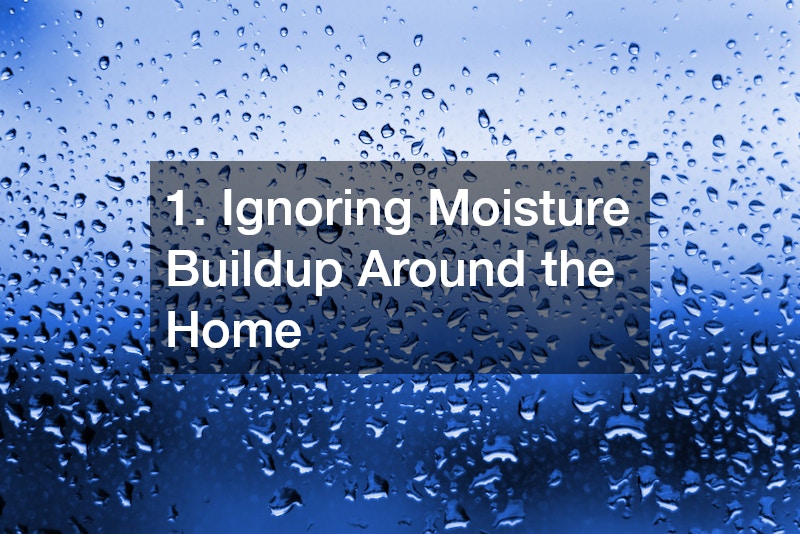Disclaimer: This website provides health information for educational purposes only and is not a substitute for professional medical advice, diagnosis, or treatment. Always seek the guidance of a qualified healthcare provider with any questions you may have.
Maintaining a healthy home isn’t just about eating well or getting enough sleep. The environment you live in every day plays a huge role in your wellness. Many people don’t realize how much their daily routines, cleaning habits, or lack of maintenance can influence the air they breathe, the water they drink, and the surfaces they touch. Small issues often build quietly over time, becoming major health concerns before anyone notices.
From lingering moisture to neglected appliances, hidden pollutants, and forgotten spaces, unhealthy habits can create long-term risks that are completely avoidable with regular care. Understanding these risks helps homeowners build safer, cleaner, and more supportive living spaces. Below are ten habits that commonly cause problems in homes and practical steps you can take to change them.
1. Ignoring Moisture Buildup Around the Home

Moisture is one of the biggest threats to a healthy home. Lingering humidity, leaks, and damp surfaces can trigger irritation, worsen allergies, and create conditions where contaminants thrive. Many homeowners notice small spots of condensation or occasional dampness but assume they will dry on their own. Unfortunately, moisture rarely stays harmless. It seeps into materials, spreads into tight spaces, and creates an environment that affects both health and structural safety. Routine inspection and proper ventilation are essential to keeping indoor humidity under control.
Homeowners often overlook how small leaks or spills can gradually create larger issues. When water sits for long periods, surfaces can deteriorate, smells develop, and irritation may increase, especially for people with sensitivities. Addressing these signs early helps prevent more serious issues.
One of the most common consequences of neglected moisture is residential water damage. Regularly checking basements, kitchens, and bathrooms can reduce the risk of widespread deterioration related to water damage.
2. Allowing Clutter to Accumulate in Living Areas
Clutter is more than just an eyesore. Stacks of paper, packed shelves, and crowded floors collect dust, restrict airflow, and create stress. Over time, cluttered spaces become harder to clean, allowing irritants to settle into fabrics and surfaces. Reduced airflow alone can influence indoor air quality, leaving rooms feeling stuffy or stale. In addition to affecting mental well-being, clutter also contributes to physical reactions in people sensitive to dust or debris.
Many homes accumulate clutter slowly. Items are set aside “just for now,” and soon entire rooms feel heavy or overwhelming. When clutter becomes part of the background, it’s easy to ignore the health impact. Regular tidying, strategic storage, and occasional purging can make a significant difference in how fresh and comfortable a home feels.
Messy areas often attract insects, especially in warm or humid environments. Keeping spaces clear reduces the likelihood of needing pest removal, but when issues arise, homeowners frequently rely on pest removal professionals to address the problem safely.
3. Forgetting to Clean or Replace Essential Filters

Filters play an essential role in maintaining healthy indoor air. Whether they’re used in HVAC systems, purifiers, or appliances, their entire purpose is to capture dust, debris, and microscopic pollutants. However, filters become less effective as they fill up, forcing machines to work harder and pushing contaminants back into the living environment. In many homes, filters are forgotten because they’re out of sight, leading to reduced air quality and increased respiratory irritation.
A neglected filter can also shorten the lifespan of major systems. When machines struggle to breathe, they overheat, break down, or distribute poor-quality air throughout the home. Regular replacement is one of the simplest ways to maintain a healthier household.
Professional cleaning services can help when systems become too clogged to manage at home. Many families rely on air duct cleaners to remove built-up debris when indoor circulation becomes compromised. Work performed by air duct cleaners helps restore efficiency and reduce airborne contaminants.
4. Keeping Old or Damaged Furniture Without Inspection
Many people hold onto items for sentimental or financial reasons, but aging household materials can introduce hidden risks. Older items often accumulate dust, moisture, and irritants deep within fabrics and frames. When furniture is rarely cleaned or inspected, its condition can decline without notice. Sagging cushions, worn coverings, and damaged wood can release particles that influence indoor air quality or create mild respiratory discomfort over time.
Some furniture materials degrade, especially in humid conditions. Household pieces placed near vents, windows, or damp corners may decay faster than expected. Regular cleaning and occasional replacement can protect indoor comfort and lessen the chance of long-term health issues.
Soft surfaces, in particular, should be managed carefully. Dust mites and irritants thrive in older furniture, especially when people or pets use these items daily. Rotating, cleaning, or replacing furniture prevents buildup and helps reduce potential irritation. Structured pieces may also require attention after years of use. Wooden furniture can suffer hidden deterioration, especially in warm regions where insects seek shelter. Periodic inspections of furniture help detect problems early and maintain a healthy living environment.
5. Overlooking Bathroom Ventilation and Routine Updates
Bathrooms are naturally high-moisture spaces that require good airflow and ongoing maintenance. Steam from showers, wet surfaces, and poor ventilation can create an environment where pollutants linger and odors develop. When homeowners neglect routine checks, moisture settles into walls and flooring, creating long-term issues that influence indoor comfort. Regular inspections of fixtures and ventilation systems help maintain a healthier space.
Updates don’t always require major renovation. Simple adjustments—like replacing worn hardware, sealing gaps, or installing better airflow solutions—can significantly improve bathroom health. Homeowners who avoid updating these areas may experience recurring moisture problems or inconvenience that affects comfort.
When bathrooms become outdated or difficult to maintain, homeowners often seek help from a local bathroom remodeling company. Professional work from a local bathroom remodeling company can enhance ventilation, improve surfaces, and reduce moisture risk.
6. Running Heating and Cooling Systems Inefficiently
Modern heating and cooling systems are designed to create comfortable indoor temperatures, but many homeowners operate them inefficiently. Running units nonstop, avoiding routine maintenance, or using incorrect settings can stress equipment and reduce air quality. When systems struggle, dust circulation increases and indoor comfort declines. Regular inspection and proper use help maintain a safer and more efficient home environment.
Humidity control is also a major factor. Units that run improperly may cause dampness, dryness, or inconsistent temperature regulation. These conditions make some households more susceptible to discomfort or irritation.
One major contributor to poor system performance is neglected maintenance. Many families rely on air conditioner services to restore efficiency during seasonal changes. Scheduling routine air conditioner services helps reduce the strain on indoor climate systems.
7. Neglecting Exterior Maintenance and Outdoor Cleaning
Outdoor areas play a big role in indoor health. When exterior surfaces accumulate pollen, dirt, or organic material, these contaminants eventually find their way inside through doors, windows, and ventilation systems. Over time, even small amounts of debris can affect air quality, trigger allergies, or irritate sensitive individuals. Decks, siding, walkways, patios, and garden furniture can all harbor dust, pollen, and other irritants that reduce comfort or contribute to lingering odors indoors. Regular cleaning of these surfaces not only keeps your property looking its best but also minimizes the risk of indoor exposure to pollutants that affect daily well-being.
Leaves, branches, and other plant debris often collect in hidden outdoor spaces such as gutters, under porches, and around landscaping features. These areas can trap moisture and create conditions conducive to mold, mildew, and insect activity. Piles of organic material also attract pests, which may eventually find their way indoors, increasing the risk of infestations or the need for professional pest removal. Regular trimming, raking, and debris removal are simple yet effective ways to maintain a cleaner, safer environment both outside and inside your home.
Many homeowners also turn to professional services to handle larger or hard-to-reach areas. For instance, scheduling house washers to clean siding, driveways, patios, and other exterior surfaces removes accumulated grime, pollen, and mold spores that may not be manageable with routine home cleaning alone. Professional house washers use high-quality equipment and techniques to ensure thorough cleaning without damaging materials. In addition to improving the visual appeal of the property, clean exterior surfaces reduce the likelihood of contaminants being carried indoors, supporting overall household hygiene and helping maintain a healthier living environment.
8. Using Old or Unsafe Storage Practices Indoors

Storage habits greatly influence how clean and organized a home remains. Improper storage can lead to contamination, stagnant air, or pest activity, all of which affect both comfort and health. Old boxes, poorly sealed containers, and overfilled closets trap dust and limit airflow, causing rooms to feel heavy, musty, or even damp over time. Inadequate ventilation in storage spaces also allows allergens and irritants to accumulate, which can aggravate respiratory issues or allergies.
Poorly maintained storage can also attract insects and rodents. Once pests settle into boxes, shelves, or attics, the resulting damage and contamination become much more difficult to manage. Rodents may chew through materials, leaving behind droppings, while insects can burrow into fabrics or wooden structures, increasing the risk of structural issues.
Closets, attics, and other rarely accessed spaces often conceal conditions that require professional attention. Many families schedule termite exterminating to protect wooden storage areas from hidden infestations or damage. Acting early with termite exterminating helps prevent further deterioration of furniture, flooring, or structural elements. In addition, when pests appear due to crowded or improper storage, some homeowners rely on pest removal services to restore cleanliness and safety. Effective pest removal ensures that storage areas remain hygienic, organized, and easier to maintain over the long term. Consistent attention to these areas creates a healthier home environment and reduces the likelihood of unexpected infestations or contamination.
9. Using Harsh Cleaners Without Proper Ventilation
Cleaning products help maintain a healthy home, but some formulas release strong fumes. When used without proper airflow, these fumes may irritate sensitive individuals or linger long after the task is complete. Even natural products can create discomfort in closed spaces. Proper ventilation is essential when using anything that produces odor or vapor.
Many homeowners underestimate how long fumes stay active in the air. Bathrooms, kitchens, and laundry rooms often require windows or fans to disperse cleaning residue. Choosing gentler products or increasing airflow can make routine cleaning safer. Bathroom cleaning often highlights the importance of updated systems. Renovating or refreshing high-moisture spaces through a local bathroom remodeling company can help improve ventilation. A local bathroom remodeling company can upgrade fixtures that promote better airflow and easier cleaning.
10. Delaying Routine Inspections and Home Maintenance

Small issues become large ones when inspections are skipped. Many homeowners postpone checks on plumbing, foundations, appliances, or structural elements because nothing seems obviously wrong. Unfortunately, gradual damage often goes unnoticed until it becomes costly and inconvenient. Routine maintenance and early intervention protect the home from bigger health and safety issues. Inspections also help keep air and water systems functioning properly. When these systems struggle, indoor comfort drops and household health may be affected. Professional help ensures components remain effective over time.
Water system checks are especially important in rural areas. Families relying on private water sources often schedule well services to ensure quality and performance. Regular well services support safer household routines. Moisture-related deterioration may also occur in areas homeowners rarely inspect. In many cases, people call for residential water damage remediation unexpectedly. Addressing minor signs early reduces the need for larger residential water damage repairs later.
When mold appears or moisture issues persist, many homeowners rely on a professional mold removal company. Experienced teams assess the extent of contamination, identify hidden mold growth, and remove affected materials safely, reducing the risk of spores spreading to other areas of the home. A professional mold removal company also provides guidance on preventing future growth, such as repairing leaks, improving ventilation, and managing indoor humidity levels.
Maintaining a healthy home is about more than cleaning or decoration—it’s about creating an environment that supports your physical and mental well-being every day. Small, often overlooked habits can lead to moisture buildup, poor air quality, pest issues, and hidden contaminants that quietly affect your health over time. By addressing these risks proactively, from routine inspections to thoughtful maintenance, you can prevent long-term problems and create a safer, more comfortable living space for everyone in your household.




